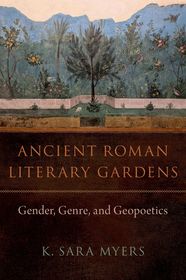
Ancient Roman Literary Gardens
Gender, Genre, and Geopoetics
- Publisher's listprice GBP 59.00
-
28 187 Ft (26 845 Ft + 5% VAT)
The price is estimated because at the time of ordering we do not know what conversion rates will apply to HUF / product currency when the book arrives. In case HUF is weaker, the price increases slightly, in case HUF is stronger, the price goes lower slightly.
- Discount 10% (cc. 2 819 Ft off)
- Discounted price 25 369 Ft (24 161 Ft + 5% VAT)
Subcribe now and take benefit of a favourable price.
Subscribe
28 187 Ft

Availability
Estimated delivery time: In stock at the publisher, but not at Prospero's office. Delivery time approx. 3-5 weeks.
Not in stock at Prospero.
Why don't you give exact delivery time?
Delivery time is estimated on our previous experiences. We give estimations only, because we order from outside Hungary, and the delivery time mainly depends on how quickly the publisher supplies the book. Faster or slower deliveries both happen, but we do our best to supply as quickly as possible.
Product details:
- Publisher OUP USA
- Date of Publication 23 December 2024
- ISBN 9780197773208
- Binding Hardback
- No. of pages312 pages
- Size 237x164x24 mm
- Weight 599 g
- Language English 733
Categories
Short description:
Through an analysis of ancient garden studies and close readings of major Latin texts from the first centuries BCE and CE, K. Sara Myers examines the function and representation of garden descriptions in the work of a broad range of Roman authors, such as Cicero, Catullus, Vergil, Varro, Horace, Ovid, Petronius, Columella, Statius, and Pliny the Elder and Younger.
MoreLong description:
Gardens are not central in Latin literature, but usually somewhere off to the side, as was often the real garden. They appear, however, in some form in nearly all literary genres of Latin literature--history, satire, epigrams, epics, letters, lyric poetry, elegies, and novels--and often edge their way into larger socio-economic and political discussions about Roman identity, gender, wealth, and land use. Through an analysis of ancient garden studies and close readings of major Latin texts from the first centuries BCE and CE, K. Sara Myers examines the function and representation of garden descriptions in the work of a broad range of Roman authors, such as Cicero, Catullus, Vergil, Varro, Horace, Ovid, Petronius, Columella, Statius, and Pliny the Elder and Younger.
While most of the sources in this study are poetic and their gardens fictional, it is still important to situate these works in their cultural and historical contexts. By understanding how to interpret the importance of these spaces in the literature in which they appear, readers will not only better comprehend the aesthetic and ethical values of the work in question, but they will also gain a better insight into ancient Roman attitudes toward gender, art, and human relationships with nature. Myers shows how some Romans constructed the garden as a space under male control: Men are cultivators, while women are cultivated. Literary gardens can symbolize a range of positive masculine ideals and identities for elite men--from the rustic farmer to the philosopher--but can also represent unmanly luxury and leisure. Women in gardens are usually sexualized, depicted as virginal or sexually transgressive, especially when they attempt to express ownership over these spaces. In almost all these texts, the artificial and artistic arrangement of the raw material of nature invites self-reflexivity, which Myers calls "geopoetics," or a "poetics of the earth."
This attractive book treats the rich topic of gardens, a significant theme in Latin literature, and illumines some key central texts with acute and rewarding analysis; its interests in gender, genre, and garden studies also make it impressively contemporary and interdisciplinary.
Table of Contents:
Introduction: Gardens, Gender, Genre, Geopoetics
Masculine Horticultural Self-Fashioning: Hard and Soft Labor
Vergil's Garden (Georgics 4.116-48): A Literary Paradigm
Women in the Garden: Catullus, Ovid, and the Greek Poetic Tradition
Trampling in the Garden: Satiric Verse and Epigram
Columella and the Poetics of Horticulture
Conclusion and Epilogue




